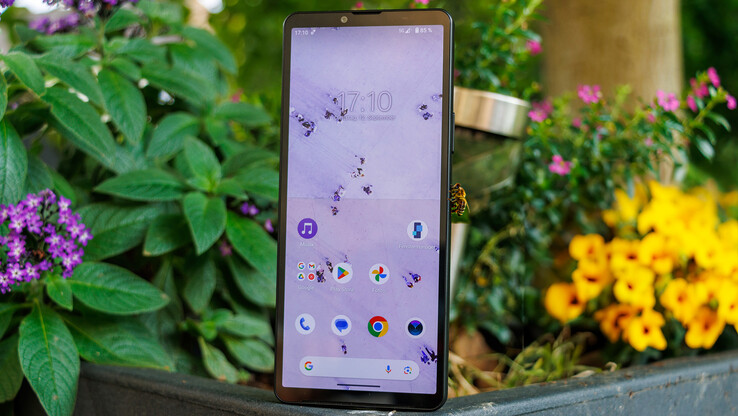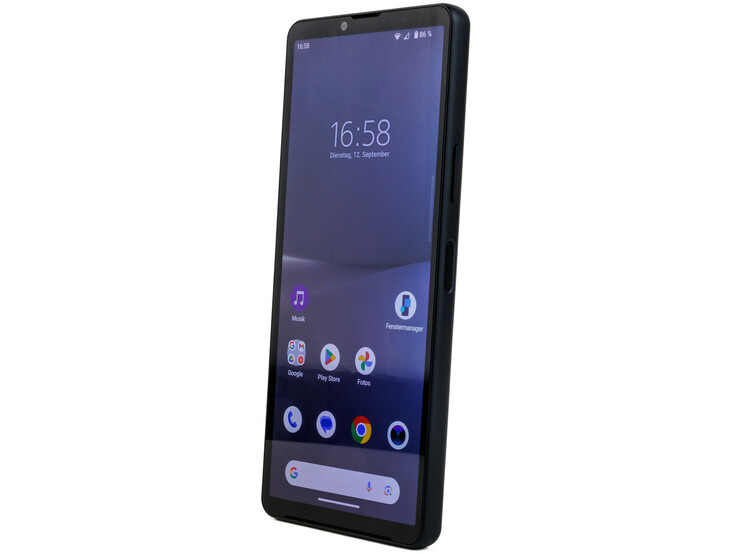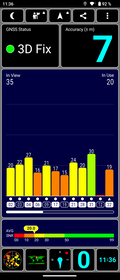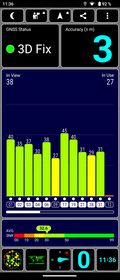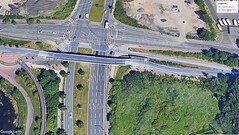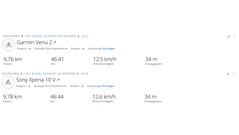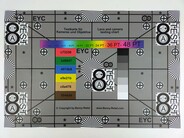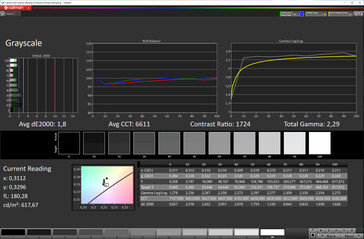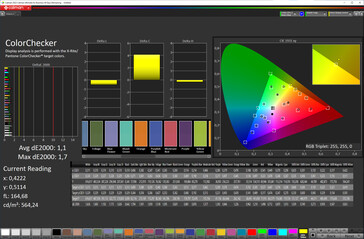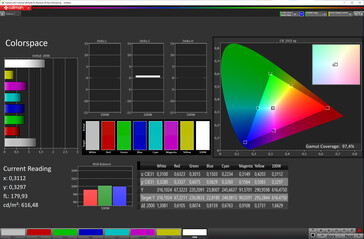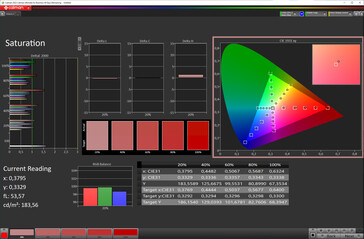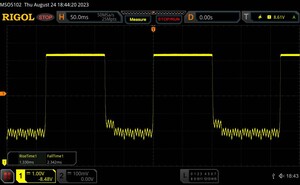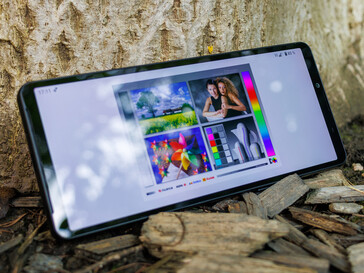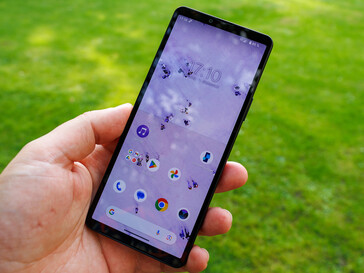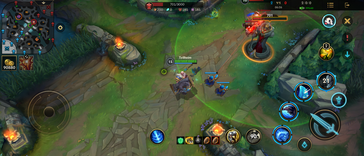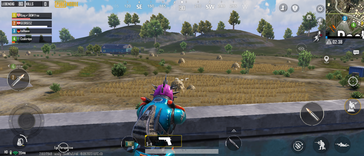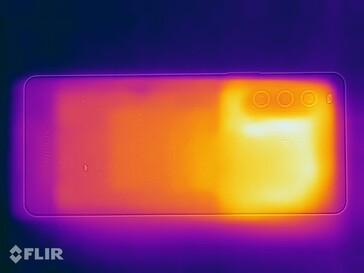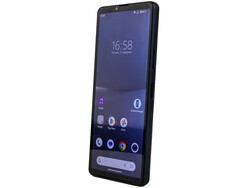Sony Xperia 10 V review - A light smartphone with tremendous staying power
At first glance, the Sony Xperia 10 V is no different from its predecessor, however, it has grown slightly and now offers stereo speakers as well as a new main sensor for the triple camera. In addition, Sony has also provided 6 GB of RAM as well as 128 GB of internal storage. The latter can be expanded with the help of a microSD card.
This year, the recommended retail price is $489 making it similar to last years model.
Possible competitors compared
Rating | Date | Model | Weight | Drive | Size | Resolution | Price |
|---|---|---|---|---|---|---|---|
| 83.1 % v7 (old) | 09 / 2023 | Sony Xperia 10 V SD 695 5G, Adreno 619 | 159 g | 128 GB UFS 2.2 Flash | 6.10" | 2520x1080 | |
| 87.1 % v7 (old) | 06 / 2023 | Google Pixel 7a Tensor G2, Mali-G710 MP7 | 193.5 g | 128 GB UFS 3.1 Flash | 6.10" | 2400x1080 | |
| 86.4 % v7 (old) | 04 / 2023 | Xiaomi 13 Lite SD 7 Gen 1, Adreno 644 | 171 g | 256 GB UFS 2.2 Flash | 6.55" | 2400x1080 | |
| 86 % v7 (old) | 05 / 2023 | Samsung Galaxy A54 5G Exynos 1380, Mali-G68 MP5 | 202 g | 128 GB UFS 2.2 Flash | 6.40" | 2340x1080 | |
| 86.8 % v7 (old) | 07 / 2023 | Motorola Edge 40 Dimensity 8020, Mali-G77 MP9 | 171 g | 256 GB UFS 3.1 Flash | 6.55" | 2400x1080 |
Case - Gorilla Glass Victus for the Xperia 10 V
The Sony Xperia 10 V is available in the colors Black, White, Lavender and Sage Green. It is slightly larger in both length and width with height remaining identical. The camera setup juts out a mere 0.95 millimeters from the case.
The Xperia 10's matte frame consists of plastic but still manages to make a premium impression. The same applies to the rear side but our black review device was very prone to attracting fingerprints. The front is protected by Corning Gorilla Glass Victus.
The build quality is impressive, the gap dimensions are tight and even, with the buttons sitting firmly in their recesses and having a clearly defined pressure point. The Sony smartphone resists attempts to twist the device without flinching. The device feels good in the hand thanks to its slim display and low weight.
Another practical feature is that the card slot can be easily opened without the need for a tool. The card tray can hold a nano SIM as well as a microSD card. The Xperia smartphone offers IPX8 splash protection and, as well as being IPX5 waterproof, it is also dustproof (IP6X).
Features - A second SIM and notification LED miss the cut
The Sony Xperia 10 V can house a nano SIM card as well as an additional or alternative eSIM. On top of that, it possesses an audio jack, NFC as well as Bluetooth 5.1.
The USB 2.0 port means you shouldn't expect high speeds. Unfortunately, we were unable to analyze this in greater detail as the Xperia failed to recognize our SSD. Connected storage devices can not only be formatted in FAT32 but also exFAT. However, NTFS is not supported and neither is wired video output.
microSD card reader
The Xperia 10 V can take microSD cards of up to 1 TB that have FAT, FAT32 or exFAT file systems. These can only be used as additional storage and not as internal storage. In our copying test, the card slot turned out to be a bit of a slowcoach, however, by contrast, it performed quite well in the Cross Platform Disk Test (CPDT).
| SD Card Reader - average JPG Copy Test (av. of 3 runs) | |
| Samsung Galaxy A54 5G (Angelbird AV Pro V60) | |
| Sony Xperia 10 IV (Angelbird AV Pro V60) | |
| Sony Xperia 10 V (Angelbird AV Pro V60) | |
Cross Platform Disk Test (CPDT)
Software - Three years of updates for the Xperia 10 V
The Sony Xperia 10 V comes with Google Android 13 and its own Xperia UI on top. At the time of review, the device has the latest updates and Sony has promised at least two major updates and three years of security patches.
Once more, the Xperia 10 V supports multi-window views which can also be stored in the task manager. With Side Sense, this can be managed quite comfortably. Sony is quite cautious when it comes to third-party apps and queries the installation thereof during the setup process. Only Facebook and LinkedIn are immediately on board and both can only be deactivated.
Communication and GNSS - Sony puts the brakes on the Wi-Fi
The Sony Xperia 10 V possesses decent frequency coverage and supports all modern mobile communication standards including 5G Sub6. In big city environments, reception is good.
In terms of Wi-Fi, the Xperia has a little surprise in store. Using our Asus ROG Rapture GT-AXE11000 router, it is only half as fast as the Xperia 10 IV. Sony has probably sacrificed the additional antenna for the second speaker or just simply omitted it. It's a pity because at this price you would be right to expect Wi-Fi 6.
| Networking | |
| Sony Xperia 10 V | |
| iperf3 receive AXE11000 | |
| iperf3 transmit AXE11000 | |
| Google Pixel 7a | |
| iperf3 receive AXE11000 | |
| iperf3 transmit AXE11000 | |
| iperf3 transmit AXE11000 6GHz | |
| iperf3 receive AXE11000 6GHz | |
| Xiaomi 13 Lite | |
| iperf3 receive AXE11000 | |
| iperf3 transmit AXE11000 | |
| Samsung Galaxy A54 5G | |
| iperf3 receive AXE11000 | |
| iperf3 transmit AXE11000 | |
| Motorola Edge 40 | |
| iperf3 receive AXE11000 | |
| iperf3 transmit AXE11000 | |
| Sony Xperia 10 IV | |
| iperf3 receive AXE11000 | |
| iperf3 transmit AXE11000 | |
| Average of class Smartphone | |
| iperf3 receive AXE11000 | |
| iperf3 transmit AXE11000 | |
| iperf3 transmit AXE11000 6GHz | |
| iperf3 receive AXE11000 6GHz | |
The Sony Xperia 10 V only has single-band GNSS but supports all global satellite networks. Even in buildings, the satellite fix happens very accurately and is also quite fast.
On a bike tour, the Sony smartphone went head-to-head with the Garmin Venu 2 and there was only a 20-meter difference in the recorded route. Only a detailed analysis of the journey revealed that the Xperia 10 occasionally veered off the beaten track. Nevertheless, the smartphone delivers good location accuracy.
Telephone functions and voice quality
The Sony Xperia 10 V can rely on a nano SIM card or eSIM meaning anyone who requires dual SIM can also use both options. For calls, every contact can be assigned an individual SIM and, as an alternative, only one SIM can be used for calls or a request can be made before every call. A dual-messenger function is not implemented in the system, neither is the management of your own SIP accounts. However, functions such as VoLTE and Wi-Fi calls are supported.
When held to the ear, the voice quality is very good but disruptive ambient noise is only partially filtered. By contrast, using the speaker mode, voices sound a little muffled but, otherwise, it works well.
Cameras - The new 48 MPix lens doesn't quite work without a hitch
From a technical point of view, the front camera is identical to its predecessor and offers 8 MPix, meaning videos can be recorded in Full HD (30fps). The image composition is very balanced but lacks a little sharpness.
The rear triple camera has received a new main sensor and can now count on 48 MPix including OIS. Sony still has some fine-tuning to do here, bright areas tend to be over-illuminated, especially with closeup shots, whereas panorama shots could be somewhat brighter. With both the ultra wide-angle lens and the 2x optical zoom, the low resolution is noticeable but, in particular, the latter offers a real advantage when compared to purely digital solutions. A maximum digital zoom of 10x is possible and this also works surprisingly well.
Videos are exclusively recorded with the main camera in Full HD (16:9) at up to 60fps. Zooming is only done digitally and also up to 10x. In addition, Sony has provided good video stabilization as well as object tracking.
Image comparison
Choose a scene and navigate within the first image. One click changes the position on touchscreens. One click on the zoomed-in image opens the original in a new window. The first image shows the scaled photograph of the test device.
Main cameraMain cameraUltra wide-angle5x zoomLow-lightUnder controlled lighting conditions, the Sony Xperia 10 V's camera delivers good imaging performance. The test chart can only be captured in 12 MPix due to the missing 48 MPix mode but remains sharp and detailed regardless, right to the edges of the image.
The ColorChecker's colors are captured comparatively naturally with the Sony smartphone only having problems with pure white.
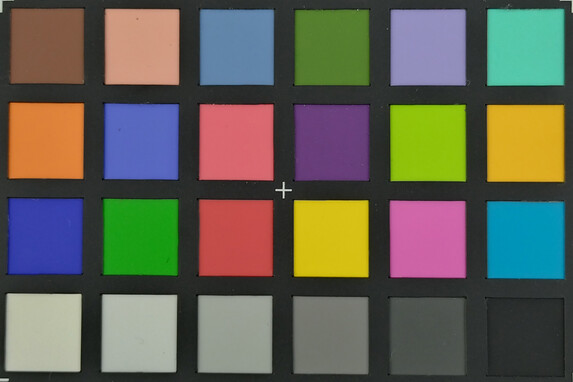

Accessories and guarantee - Just a lot of paper
The Sony Xperia 10 V comes without any accessories to speak of – neither a USB cable nor a charger. However, this can be purchased optionally from Sony. In addition to the smartphone itself, the slim cardboard box only contains many small, folded booklets in various languages.
The guarantee is for 24 months and cannot be extended.
Input devices & operation - The Xperia 10 V doesn't come with face recognition
In tests, the Sony Xperia 10 V's capacitive touchscreen works very reliably, not least due to the low refresh and sampling rates, but is not above average speed.
In terms of biometric security, only a fingerprint sensor is available and this is integrated into the power button. Sony has opted against using unsafe facial recognition via the front camera. The fingerprint scanner works very smoothly but the speed can only be described as average. On the one hand, the vibration motor is quite powerful but the Xperia 10 Mark V uses a cheaper ERM model and this results in rather spongy haptic feedback.
In addition to Side Sense, Sony's smartphone also offers a one-handed mode as well as an optional battery management mode.
Display - Brightness plus points for the Xperia 10 V
The Sony Xperia 10 V's OLED display is slightly bigger and now measures 6.1 inches (15.49 cm, 86.92 cm²) with a slim aspect ratio of 21:9. The refresh rate is only limited to 60 Hz and, in addition, the Xperia only supports the HDR standards HLG and HDR10.
When it comes to brightness, the Sony cell phone has made a great leap forward and can now reach a very balanced average brightness of 944 cd/m² with a completely white screen. With an even split of light and dark areas (APL18), the brightness hardly increases and achieves 978 cd/m² in the middle of the display. If you don't want the ambient light sensor to regulate the brightness, you have 612 cd/m² at your disposal.
At minimum brightness, the oscilloscope showed a very fluctuating amplitude curve of between 79 and 292 Hz. Above 48 percent of the adjustable brightness, this becomes more uniform and operates at a relatively constant 60 - 120 Hz. The flicker meter confirmed that the Xperia 10 V has a maximum of 240 Hz. Sensitive users can therefore bank on experiencing issues.
| |||||||||||||||||||||||||
Brightness Distribution: 97 %
Center on Battery: 933 cd/m²
Contrast: ∞:1 (Black: 0 cd/m²)
ΔE ColorChecker Calman: 1.1 | ∀{0.5-29.43 Ø4.79}
ΔE Greyscale Calman: 1.8 | ∀{0.09-98 Ø5}
97.4% sRGB (Calman 2D)
Gamma: 2.29
CCT: 6611 K
| Sony Xperia 10 V OLED, 2520x1080, 6.1" | Google Pixel 7a OLED, 2400x1080, 6.1" | Xiaomi 13 Lite AMOLED, 2400x1080, 6.6" | Samsung Galaxy A54 5G Super AMOLED, 2340x1080, 6.4" | Motorola Edge 40 OLED, 2400x1080, 6.6" | Sony Xperia 10 IV OLED, 2520x1080, 6" | |
|---|---|---|---|---|---|---|
| Screen | -3% | -16% | -38% | -40% | -2% | |
| Brightness middle (cd/m²) | 933 | 1006 8% | 905 -3% | 940 1% | 1023 10% | 572 -39% |
| Brightness (cd/m²) | 944 | 1010 7% | 904 -4% | 935 -1% | 1042 10% | 580 -39% |
| Brightness Distribution (%) | 97 | 95 -2% | 99 2% | 99 2% | 90 -7% | 96 -1% |
| Black Level * (cd/m²) | ||||||
| Colorchecker dE 2000 * | 1.1 | 1.1 -0% | 1 9% | 2.4 -118% | 1.6 -45% | 0.9 18% |
| Colorchecker dE 2000 max. * | 1.7 | 2.5 -47% | 3 -76% | 3.2 -88% | 4.3 -153% | 1.2 29% |
| Greyscale dE 2000 * | 1.8 | 1.5 17% | 2.2 -22% | 2.2 -22% | 2.8 -56% | 1.4 22% |
| Gamma | 2.29 96% | 2.25 98% | 2.23 99% | 2.05 107% | 2.27 97% | 2.29 96% |
| CCT | 6611 98% | 6531 100% | 6382 102% | 6422 101% | 6457 101% | 6614 98% |
* ... smaller is better
Screen Flickering / PWM (Pulse-Width Modulation)
| Screen flickering / PWM detected | 137 Hz | ||
The display backlight flickers at 137 Hz (worst case, e.g., utilizing PWM) . The frequency of 137 Hz is very low, so the flickering may cause eyestrain and headaches after extended use. In comparison: 53 % of all tested devices do not use PWM to dim the display. If PWM was detected, an average of 8163 (minimum: 5 - maximum: 343500) Hz was measured. | |||
A series of measurements with fixed levels of zoom and various brightness settings
We used the photo spectrometer and the CalMAN analysis software to examine the Sony Xperia 10 V's display properties in greater detail. In Original mode, we achieved the most natural results which are very good. With the naked eye, it's not possible to determine any color deviations.
Display Response Times
| ↔ Response Time Black to White | ||
|---|---|---|
| 2.36 ms ... rise ↗ and fall ↘ combined | ↗ 1.19 ms rise | |
| ↘ 1.168 ms fall | ||
| The screen shows very fast response rates in our tests and should be very well suited for fast-paced gaming. In comparison, all tested devices range from 0.1 (minimum) to 240 (maximum) ms. » 11 % of all devices are better. This means that the measured response time is better than the average of all tested devices (20.3 ms). | ||
| ↔ Response Time 50% Grey to 80% Grey | ||
| 3.67 ms ... rise ↗ and fall ↘ combined | ↗ 1.33 ms rise | |
| ↘ 2.342 ms fall | ||
| The screen shows very fast response rates in our tests and should be very well suited for fast-paced gaming. In comparison, all tested devices range from 0.165 (minimum) to 636 (maximum) ms. » 13 % of all devices are better. This means that the measured response time is better than the average of all tested devices (31.7 ms). | ||
Performance - Life in the slow lane with the SD695
Considering the Xperia 10 V's price range, the Snapdragon 695 5G is somewhat underpowered. For this reason, it's hardly surprising that, compared to its peers, the Sony smartphone is at the bottom of the pack in every area. In everyday use, the system performance is acceptable but anyone wishing to frequently multitask will have to come to terms with stuttering.
| UL Procyon AI Inference for Android - Overall Score NNAPI | |
| Google Pixel 7a | |
| Xiaomi 13 Lite | |
| Motorola Edge 40 | |
| Average of class Smartphone (3769 - 81594, n=137, last 2 years) | |
| Sony Xperia 10 IV | |
| Average Qualcomm Snapdragon 695 5G (5442 - 9348, n=15) | |
| Samsung Galaxy A54 5G | |
| Sony Xperia 10 V | |
When it comes to GPUs, the Adreno 619 is a real dinosaur and has been on the market for over three years. It debuted as part of the Snapdragon 400 series SoCs. This is noticeable in benchmarks with the Xperia 10 V finding itself at the bottom of the table, without exception.
GFXBench (DX / GLBenchmark) 2.7: T-Rex Onscreen | 1920x1080 T-Rex Offscreen
GFXBench 3.0: on screen Manhattan Onscreen OGL | 1920x1080 1080p Manhattan Offscreen
GFXBench 3.1: on screen Manhattan ES 3.1 Onscreen | 1920x1080 Manhattan ES 3.1 Offscreen
GFXBench: on screen Car Chase Onscreen | 1920x1080 Car Chase Offscreen | on screen Aztec Ruins High Tier Onscreen | 2560x1440 Aztec Ruins High Tier Offscreen | on screen Aztec Ruins Normal Tier Onscreen | 1920x1080 Aztec Ruins Normal Tier Offscreen | 3840x2160 4K Aztec Ruins High Tier Offscreen
| 3DMark / Wild Life Extreme Unlimited | |
| Google Pixel 7a | |
| Motorola Edge 40 | |
| Xiaomi 13 Lite | |
| Samsung Galaxy A54 5G | |
| Sony Xperia 10 IV | |
| Sony Xperia 10 V | |
| 3DMark / Wild Life Extreme | |
| Google Pixel 7a | |
| Motorola Edge 40 | |
| Xiaomi 13 Lite | |
| Samsung Galaxy A54 5G | |
| Sony Xperia 10 IV | |
| Sony Xperia 10 V | |
| 3DMark / Wild Life Unlimited Score | |
| Google Pixel 7a | |
| Motorola Edge 40 | |
| Xiaomi 13 Lite | |
| Samsung Galaxy A54 5G | |
| Sony Xperia 10 IV | |
| Sony Xperia 10 V | |
| 3DMark / Wild Life Score | |
| Google Pixel 7a | |
| Motorola Edge 40 | |
| Xiaomi 13 Lite | |
| Samsung Galaxy A54 5G | |
| Sony Xperia 10 IV | |
| Sony Xperia 10 V | |
| 3DMark / Sling Shot Extreme (ES 3.1) Unlimited Physics | |
| Motorola Edge 40 | |
| Google Pixel 7a | |
| Samsung Galaxy A54 5G | |
| Sony Xperia 10 V | |
| Sony Xperia 10 IV | |
| Xiaomi 13 Lite | |
| 3DMark / Sling Shot Extreme (ES 3.1) Unlimited Graphics | |
| Google Pixel 7a | |
| Motorola Edge 40 | |
| Xiaomi 13 Lite | |
| Samsung Galaxy A54 5G | |
| Sony Xperia 10 IV | |
| Sony Xperia 10 V | |
| 3DMark / Sling Shot Extreme (ES 3.1) Unlimited | |
| Google Pixel 7a | |
| Motorola Edge 40 | |
| Xiaomi 13 Lite | |
| Samsung Galaxy A54 5G | |
| Sony Xperia 10 IV | |
| Sony Xperia 10 V | |
| GFXBench (DX / GLBenchmark) 2.7 / T-Rex Onscreen | |
| Motorola Edge 40 | |
| Xiaomi 13 Lite | |
| Samsung Galaxy A54 5G | |
| Google Pixel 7a | |
| Sony Xperia 10 IV | |
| Sony Xperia 10 V | |
| GFXBench (DX / GLBenchmark) 2.7 / T-Rex Offscreen | |
| Google Pixel 7a | |
| Motorola Edge 40 | |
| Xiaomi 13 Lite | |
| Samsung Galaxy A54 5G | |
| Sony Xperia 10 IV | |
| Sony Xperia 10 V | |
| GFXBench 3.0 / Manhattan Onscreen OGL | |
| Google Pixel 7a | |
| Xiaomi 13 Lite | |
| Samsung Galaxy A54 5G | |
| Motorola Edge 40 | |
| Sony Xperia 10 IV | |
| Sony Xperia 10 V | |
| GFXBench 3.0 / 1080p Manhattan Offscreen | |
| Google Pixel 7a | |
| Xiaomi 13 Lite | |
| Samsung Galaxy A54 5G | |
| Motorola Edge 40 | |
| Sony Xperia 10 IV | |
| Sony Xperia 10 V | |
| GFXBench 3.1 / Manhattan ES 3.1 Onscreen | |
| Xiaomi 13 Lite | |
| Google Pixel 7a | |
| Samsung Galaxy A54 5G | |
| Motorola Edge 40 | |
| Sony Xperia 10 IV | |
| Sony Xperia 10 V | |
| GFXBench 3.1 / Manhattan ES 3.1 Offscreen | |
| Google Pixel 7a | |
| Xiaomi 13 Lite | |
| Samsung Galaxy A54 5G | |
| Motorola Edge 40 | |
| Sony Xperia 10 IV | |
| Sony Xperia 10 V | |
| GFXBench / Car Chase Onscreen | |
| Google Pixel 7a | |
| Motorola Edge 40 | |
| Xiaomi 13 Lite | |
| Samsung Galaxy A54 5G | |
| Sony Xperia 10 IV | |
| Sony Xperia 10 V | |
| GFXBench / Car Chase Offscreen | |
| Google Pixel 7a | |
| Motorola Edge 40 | |
| Xiaomi 13 Lite | |
| Samsung Galaxy A54 5G | |
| Sony Xperia 10 IV | |
| Sony Xperia 10 V | |
| GFXBench / Aztec Ruins High Tier Onscreen | |
| Google Pixel 7a | |
| Motorola Edge 40 | |
| Xiaomi 13 Lite | |
| Samsung Galaxy A54 5G | |
| Sony Xperia 10 IV | |
| Sony Xperia 10 V | |
| GFXBench / Aztec Ruins High Tier Offscreen | |
| Google Pixel 7a | |
| Motorola Edge 40 | |
| Xiaomi 13 Lite | |
| Samsung Galaxy A54 5G | |
| Sony Xperia 10 IV | |
| Sony Xperia 10 V | |
| GFXBench / Aztec Ruins Normal Tier Onscreen | |
| Google Pixel 7a | |
| Motorola Edge 40 | |
| Xiaomi 13 Lite | |
| Samsung Galaxy A54 5G | |
| Sony Xperia 10 IV | |
| Sony Xperia 10 V | |
| GFXBench / Aztec Ruins Normal Tier Offscreen | |
| Google Pixel 7a | |
| Motorola Edge 40 | |
| Xiaomi 13 Lite | |
| Samsung Galaxy A54 5G | |
| Sony Xperia 10 IV | |
| Sony Xperia 10 V | |
| GFXBench / 4K Aztec Ruins High Tier Offscreen | |
| Google Pixel 7a | |
| Motorola Edge 40 | |
| Xiaomi 13 Lite | |
| Samsung Galaxy A54 5G | |
| Sony Xperia 10 IV | |
| Sony Xperia 10 V | |
When surfing the web, the Sony Xperia 10 V scores well and manages to guide its users speedily through the internet. In the benchmarks, the smartphone is placed in the middle of the pack.
| Jetstream 2 - 2.0 Total Score | |
| Average of class Smartphone (23.8 - 387, n=154, last 2 years) | |
| Google Pixel 7a (Chrome 114) | |
| Samsung Galaxy A54 5G (Chrome 112) | |
| Sony Xperia 10 V (Chrome 116) | |
| Xiaomi 13 Lite (Chrome 111.0.5563.115) | |
| Average Qualcomm Snapdragon 695 5G (48.6 - 105.3, n=19) | |
| Motorola Edge 40 (Chrome 114.0.5735.57) | |
| Sony Xperia 10 IV (Chrome 103.0.5060.129) | |
| Speedometer 2.0 - Result 2.0 | |
| Average of class Smartphone (15.2 - 643, n=131, last 2 years) | |
| Google Pixel 7a (Chrome 114) | |
| Sony Xperia 10 V (Chrome 116) | |
| Samsung Galaxy A54 5G (Chrome 112) | |
| Motorola Edge 40 (Chrome 114.0.5735.57) | |
| Xiaomi 13 Lite (Chrome 111.0.5563.115) | |
| Average Qualcomm Snapdragon 695 5G (38.7 - 80.1, n=16) | |
| Sony Xperia 10 IV (Chrome 103.0.5060.129) | |
| WebXPRT 4 - Overall | |
| Average of class Smartphone (27 - 306, n=147, last 2 years) | |
| Google Pixel 7a (Chrome 114) | |
| Samsung Galaxy A54 5G (Chrome 112) | |
| Xiaomi 13 Lite (Chrome 111.0.5563.115) | |
| Motorola Edge 40 (Chrome 114.0.5735.57) | |
| Average Qualcomm Snapdragon 695 5G (58 - 111, n=18) | |
| Sony Xperia 10 V (Chrome 116) | |
| Sony Xperia 10 IV (Chrome 103.0.5060.129) | |
| Octane V2 - Total Score | |
| Average of class Smartphone (2228 - 121337, n=200, last 2 years) | |
| Google Pixel 7a (Chrome 114) | |
| Samsung Galaxy A54 5G (Chrome 112) | |
| Sony Xperia 10 V (Chrome 116) | |
| Motorola Edge 40 (Chrome 114.0.5735.57) | |
| Xiaomi 13 Lite (Chrome 111.0.5563.115) | |
| Average Qualcomm Snapdragon 695 5G (17849 - 31647, n=21) | |
| Sony Xperia 10 IV (Chrome 103.0.5060.129) | |
| Mozilla Kraken 1.1 - Total | |
| Sony Xperia 10 IV (Chrome 103.0.5060.129) | |
| Average Qualcomm Snapdragon 695 5G (1298 - 2501, n=18) | |
| Motorola Edge 40 (Chrome 114.0.5735.57) | |
| Sony Xperia 10 V (Chrome 116) | |
| Xiaomi 13 Lite (Chrome 111.0.5563.115) | |
| Samsung Galaxy A54 5G (Chrome 112) | |
| Average of class Smartphone (257 - 28190, n=155, last 2 years) | |
| Google Pixel 7a (Chrome 114) | |
* ... smaller is better
In tests, the Xperia 10 V's UFS memory showed itself to be very slow. However, that can be traced back to the SoC's memory controller rather than the memory itself.
| Sony Xperia 10 V | Google Pixel 7a | Xiaomi 13 Lite | Samsung Galaxy A54 5G | Motorola Edge 40 | Sony Xperia 10 IV | Average 128 GB UFS 2.2 Flash | Average of class Smartphone | |
|---|---|---|---|---|---|---|---|---|
| AndroBench 3-5 | 121% | 91% | -7% | 165% | 12% | 28% | 222% | |
| Sequential Read 256KB (MB/s) | 444.54 | 1624.39 265% | 1001.82 125% | 528.32 19% | 1876.88 322% | 521.1 17% | 736 ? 66% | 2216 ? 398% |
| Sequential Write 256KB (MB/s) | 438.02 | 996.44 127% | 871.96 99% | 335.39 -23% | 1587.93 263% | 497.61 14% | 532 ? 21% | 1832 ? 318% |
| Random Read 4KB (MB/s) | 175.72 | 229.44 31% | 277.33 58% | 236.23 34% | 235.66 34% | 192.5 10% | 193 ? 10% | 293 ? 67% |
| Random Write 4KB (MB/s) | 165.15 | 263.81 60% | 301.41 83% | 70.52 -57% | 229.44 39% | 177.83 8% | 186.3 ? 13% | 340 ? 106% |
Games - This doesn't feel like gaming fun
The Adreno 619 only delivers low graphics acceleration but it still manages to display games such as League of Legends at 60fps with maximum details. When it comes to more demanding titles such as PUBG Mobile, the lights already go out in HD settings at 30fps and this is something we analyzed using GameBench.
The 21:9 display isn't particularly good for gaming due to its small size. It doesn't provide a very good overview with game content appearing very small when displayed in landscape mode.
Emissions - The Xperia 10 now comes with stereo speakers
Temperature
Even under load, the Sony Xperia's surface temperatures remain very low and only occasionally tiptoe over the 40-degree mark.
In addition, in the 3DMark stress tests, the device remained consistently stable and had access to its full power.
(±) The maximum temperature on the upper side is 40.5 °C / 105 F, compared to the average of 35.2 °C / 95 F, ranging from 21.9 to 247 °C for the class Smartphone.
(±) The bottom heats up to a maximum of 40.8 °C / 105 F, compared to the average of 34 °C / 93 F
(+) In idle usage, the average temperature for the upper side is 28.1 °C / 83 F, compared to the device average of 32.9 °C / 91 F.
3DMark Wild Life Stress Test
| 3DMark | |
| Wild Life Stress Test Stability | |
| Sony Xperia 10 V | |
| Sony Xperia 10 IV | |
| Xiaomi 13 Lite | |
| Motorola Edge 40 | |
| Samsung Galaxy A54 5G | |
| Google Pixel 7a | |
| Wild Life Extreme Stress Test | |
| Xiaomi 13 Lite | |
| Samsung Galaxy A54 5G | |
| Motorola Edge 40 | |
| Sony Xperia 10 V | |
| Sony Xperia 10 IV | |
| Google Pixel 7a | |
Speakers
The Sony Xperia 10 V's two speakers provide pleasant sound output with balanced mids and highs even at maximum volume. In spite of this, the sound still comes across as muffled and lacks volume.
In the meantime, an audio jack - which in this case is also good (SNR: 73.82 dBFS) - is something that can not be taked for granted nowadays. Alternatively, Bluetooth 5.2 is available and it supports a wide range of audio codecs, including LC3.
Sony Xperia 10 V audio analysis
(+) | speakers can play relatively loud (89.2 dB)
Bass 100 - 315 Hz
(-) | nearly no bass - on average 36% lower than median
(±) | linearity of bass is average (8% delta to prev. frequency)
Mids 400 - 2000 Hz
(+) | balanced mids - only 4.8% away from median
(+) | mids are linear (6% delta to prev. frequency)
Highs 2 - 16 kHz
(+) | balanced highs - only 1.8% away from median
(+) | highs are linear (2% delta to prev. frequency)
Overall 100 - 16.000 Hz
(±) | linearity of overall sound is average (20.4% difference to median)
Compared to same class
» 33% of all tested devices in this class were better, 9% similar, 58% worse
» The best had a delta of 12%, average was 35%, worst was 134%
Compared to all devices tested
» 52% of all tested devices were better, 8% similar, 40% worse
» The best had a delta of 4%, average was 24%, worst was 134%
Samsung Galaxy A54 5G audio analysis
(+) | speakers can play relatively loud (88.7 dB)
Bass 100 - 315 Hz
(-) | nearly no bass - on average 23.2% lower than median
(±) | linearity of bass is average (11.3% delta to prev. frequency)
Mids 400 - 2000 Hz
(±) | reduced mids - on average 6.4% lower than median
(+) | mids are linear (5.5% delta to prev. frequency)
Highs 2 - 16 kHz
(±) | higher highs - on average 6% higher than median
(+) | highs are linear (2.8% delta to prev. frequency)
Overall 100 - 16.000 Hz
(±) | linearity of overall sound is average (17.8% difference to median)
Compared to same class
» 13% of all tested devices in this class were better, 8% similar, 78% worse
» The best had a delta of 12%, average was 35%, worst was 134%
Compared to all devices tested
» 35% of all tested devices were better, 8% similar, 57% worse
» The best had a delta of 4%, average was 24%, worst was 134%
Battery runtime - The Xperia 10 V haggles for every mW
Power consumption
If we already managed to describe the Xperia 10 IV as economical, the Mark V goes one better. That is especially impressive and is even better than the Pixel 7a. Although, it must be said that that device has around 150 cd/m² less brightness at its disposal.
The difference to its predecessor under load can be traced back to the benchmark switch since we now use Burnout which puts the system under significantly greater stress.
The 5,000 mAh battery supports USB PD. With a suitably compatible charger, a full charge still takes around two hours. The final 20 percent requires a lot of time since reaching the 80 percent mark only takes around 78 minutes. The focus here is on the battery's durability. Wireless charging is not supported.
| Off / Standby | |
| Idle | |
| Load |
|
Key:
min: | |
| Sony Xperia 10 V 5000 mAh | Google Pixel 7a 4385 mAh | Xiaomi 13 Lite 4500 mAh | Samsung Galaxy A54 5G 5000 mAh | Motorola Edge 40 4400 mAh | Sony Xperia 10 IV 5000 mAh | Average Qualcomm Snapdragon 695 5G | Average of class Smartphone | |
|---|---|---|---|---|---|---|---|---|
| Power Consumption | -27% | -33% | -44% | -41% | -23% | -44% | -63% | |
| Idle Minimum * (Watt) | 0.56 | 0.62 -11% | 0.74 -32% | 0.75 -34% | 0.62 -11% | 0.68 -21% | 0.886 ? -58% | 0.856 ? -53% |
| Idle Average * (Watt) | 0.91 | 0.87 4% | 1.56 -71% | 1.51 -66% | 1.78 -96% | 1.69 -86% | 1.76 ? -93% | 1.437 ? -58% |
| Idle Maximum * (Watt) | 0.98 | 0.95 3% | 1.59 -62% | 1.62 -65% | 1.85 -89% | 1.73 -77% | 1.92 ? -96% | 1.612 ? -64% |
| Load Average * (Watt) | 5.34 | 6.11 -14% | 3.33 38% | 4.91 8% | 3.02 43% | 2.54 52% | 3.86 ? 28% | 7.1 ? -33% |
| Load Maximum * (Watt) | 5.46 | 11.81 -116% | 7.59 -39% | 8.93 -64% | 8.23 -51% | 4.61 16% | 5.45 ? -0% | 11.2 ? -105% |
* ... smaller is better
Power consumption: Geekbench (150 cd/m²)
Power consumption: GFXBench (150 cd/m²)
Battery life
The battery runtimes are nearly identical to last year's model which is not surprising considering the use of the same SoC and identical-sized battery. It was only in the Reader’s test (with minimum brightness) that the Xperia 10 V displayed its further reduced consumption, allowing it an additional four hours of battery life. By contrast, the device's staying power sank under full load because the Burnout benchmarks drain the energy storage.
The two Sony smartphones leave the competition far behind.
| Sony Xperia 10 V 5000 mAh | Google Pixel 7a 4385 mAh | Xiaomi 13 Lite 4500 mAh | Samsung Galaxy A54 5G 5000 mAh | Motorola Edge 40 4400 mAh | Sony Xperia 10 IV 5000 mAh | |
|---|---|---|---|---|---|---|
| Battery runtime | -39% | -29% | -23% | -27% | 1% | |
| Reader / Idle (h) | 67.8 | 22.1 -67% | 37.3 -45% | 43.2 -36% | 37.9 -44% | 62.7 -8% |
| H.264 (h) | 26.9 | 20.4 -24% | 19.8 -26% | 25.1 -7% | 20.6 -23% | 26.3 -2% |
| WiFi v1.3 (h) | 19.3 | 13.7 -29% | 13.7 -29% | 15.7 -19% | 15.4 -20% | 19.5 1% |
| Load (h) | 6.5 | 4.2 -35% | 5.4 -17% | 4.7 -28% | 5.1 -22% | 7.2 11% |
Pros
Cons
Verdict - More than expected
From the off, it appears that the Sony Xperia 10 V is a rebranded Mark IV, however, looks can be deceiving. Out goes without saying that there are not a huge number of innovations on board but there are still a few that stand out in everyday use. Above all, these include the OLED display's much-improved brightness as well as the stereo speakers.
Anyone on the hunt for a light smartphone with tremendous battery life can grab the Sony Xperia 10 V.
The obvious changes such as the slight increase in the dimensions and the marginally larger display are not much of a factor when it comes to everyday use. Some people will be annoyed at Sony dropping the second physical SIM slot; still, the Japanese company has stayed true to its product line, once again, equipping the Xperia 10 V with an audio jack and microSD support. This is something which almost borders on being a unique selling point in this price segment.
Three years of updates isn't especially long but, it should be said, this represents a minimum time period and given the weak SoC we don't believe Sony will offer the device anything more, in this regard. The SoC is actually the biggest area of criticism and doesn't really match the price category.
Not only longer updates and better performance can be found in the form of the Galaxy A54 and the Pixel 7a, but also poorer battery life and a modest feature set. If you just want performance and can do without the IP certification, the Poco F5 is worth taking a look at.
Price and availability
In the US, the Sony Xperia 10 V can currently be purchased on Amazon for $389.
Sony Xperia 10 V
- 09/20/2023 v7 (old)
Daniel Schmidt
Transparency
The selection of devices to be reviewed is made by our editorial team. The test sample was provided to the author as a loan by the manufacturer or retailer for the purpose of this review. The lender had no influence on this review, nor did the manufacturer receive a copy of this review before publication. There was no obligation to publish this review. As an independent media company, Notebookcheck is not subjected to the authority of manufacturers, retailers or publishers.
This is how Notebookcheck is testing
Every year, Notebookcheck independently reviews hundreds of laptops and smartphones using standardized procedures to ensure that all results are comparable. We have continuously developed our test methods for around 20 years and set industry standards in the process. In our test labs, high-quality measuring equipment is utilized by experienced technicians and editors. These tests involve a multi-stage validation process. Our complex rating system is based on hundreds of well-founded measurements and benchmarks, which maintains objectivity. Further information on our test methods can be found here.




